Annotated Bibliography: HRM Practices in Telecommunication Sector
VerifiedAdded on 2023/01/18
|18
|3099
|66
Annotated Bibliography
AI Summary
This annotated bibliography compiles five peer-reviewed journal articles that delve into various aspects of Human Resource Management (HRM) within the telecommunication sector. The first article examines the impact of Electronic HRM (E-HRM) practices on business performance in Jordan, focusing on employee perspectives and the influence of time, cost, quality, and flexibility factors. The second article investigates employee motivation in the telecommunication industry of Bangladesh, identifying key motivational factors such as career growth and job security. The third article explores the impact of HRM practices on employee commitment in Pakistan's telecom sector, emphasizing the significance of career planning and compensation. The fourth article analyzes the effect of emotional intelligence on job satisfaction in the Jordanian telecommunication sector. The fifth article explores the impact of HR practices on employee performance, organizational commitment, and job satisfaction within the telecom sector. Each entry includes a full reference, an outline of the research objective, methodology, key findings, and a summary of the conclusion, along with the relevance of the study to the broader field of HRM. This bibliography provides a comprehensive overview of current research in the field, offering valuable insights into employee motivation, organizational performance, and the effectiveness of HRM practices in the telecommunications industry.
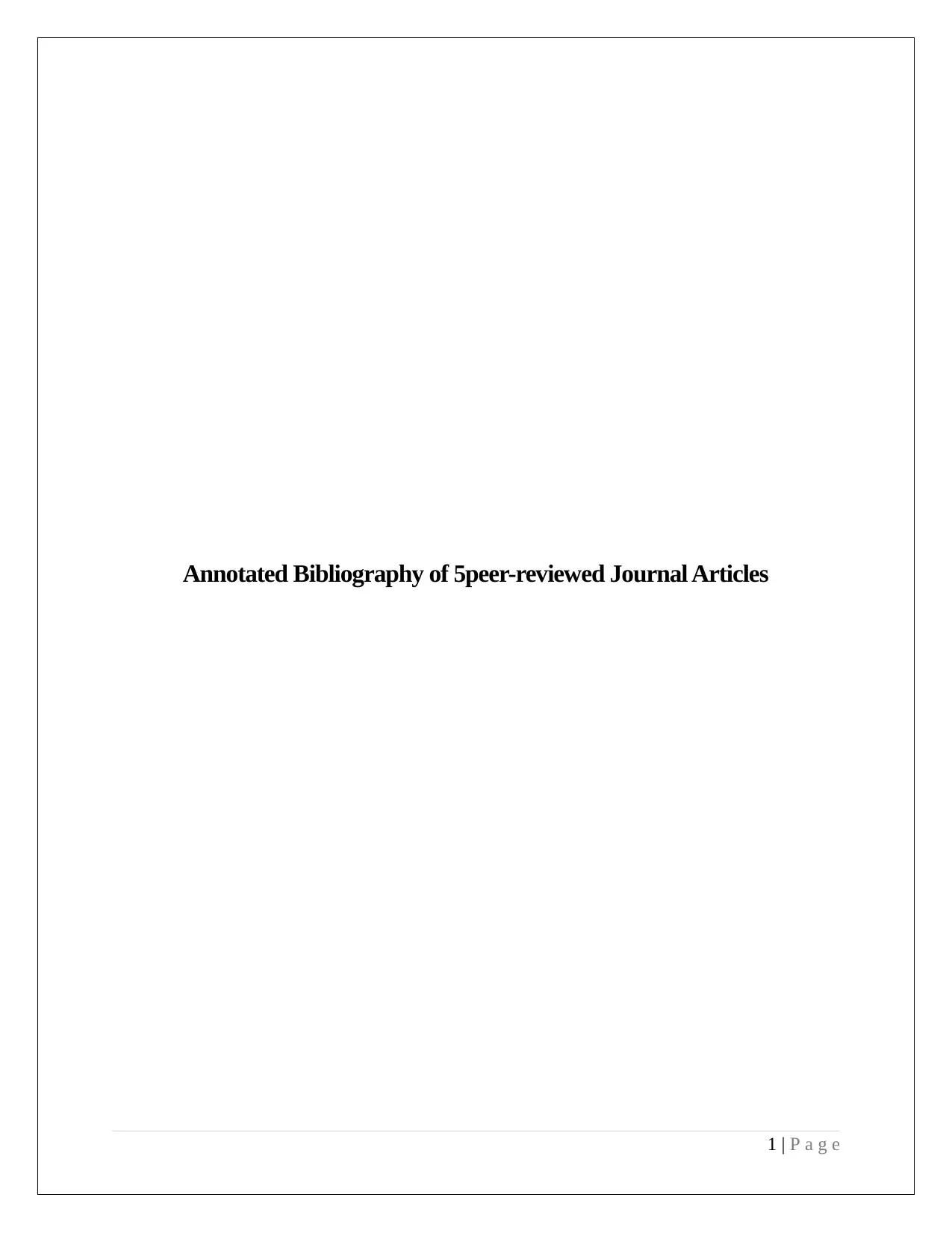
Annotated Bibliography of 5peer-reviewed Journal Articles
1 | P a g e
1 | P a g e
Paraphrase This Document
Need a fresh take? Get an instant paraphrase of this document with our AI Paraphraser
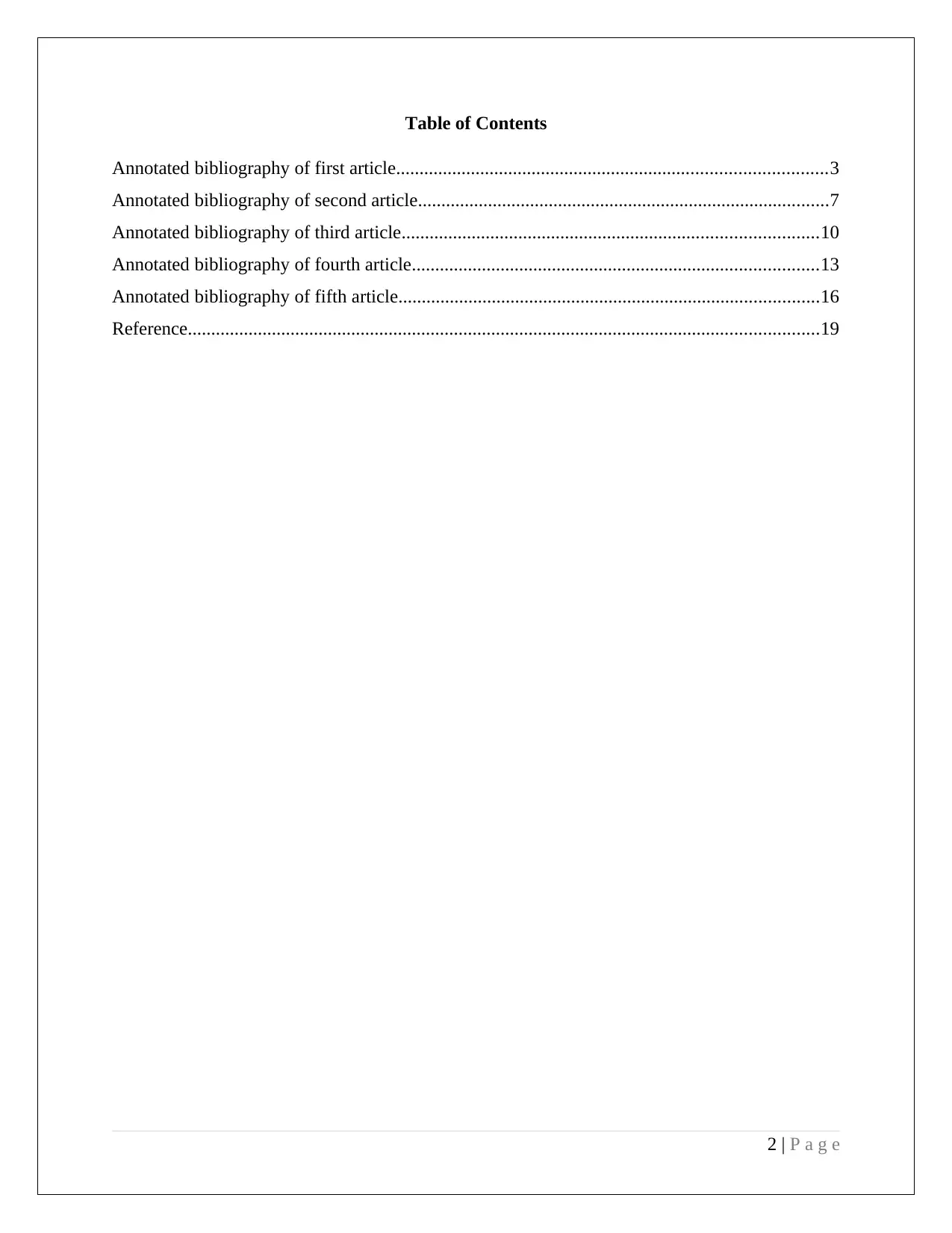
Table of Contents
Annotated bibliography of first article............................................................................................3
Annotated bibliography of second article........................................................................................7
Annotated bibliography of third article.........................................................................................10
Annotated bibliography of fourth article.......................................................................................13
Annotated bibliography of fifth article..........................................................................................16
Reference.......................................................................................................................................19
2 | P a g e
Annotated bibliography of first article............................................................................................3
Annotated bibliography of second article........................................................................................7
Annotated bibliography of third article.........................................................................................10
Annotated bibliography of fourth article.......................................................................................13
Annotated bibliography of fifth article..........................................................................................16
Reference.......................................................................................................................................19
2 | P a g e
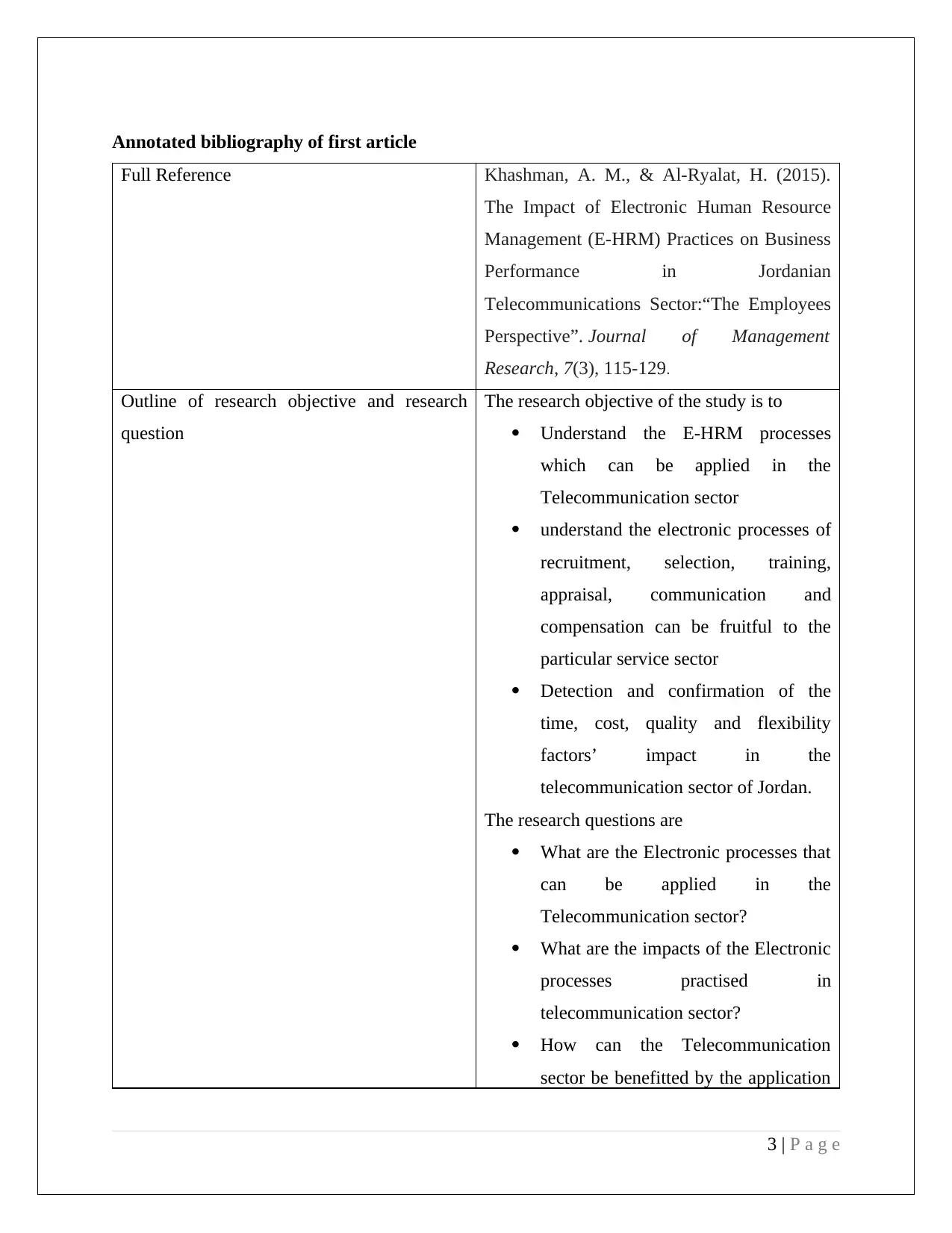
Annotated bibliography of first article
Full Reference Khashman, A. M., & Al-Ryalat, H. (2015).
The Impact of Electronic Human Resource
Management (E-HRM) Practices on Business
Performance in Jordanian
Telecommunications Sector:“The Employees
Perspective”. Journal of Management
Research, 7(3), 115-129.
Outline of research objective and research
question
The research objective of the study is to
Understand the E-HRM processes
which can be applied in the
Telecommunication sector
understand the electronic processes of
recruitment, selection, training,
appraisal, communication and
compensation can be fruitful to the
particular service sector
Detection and confirmation of the
time, cost, quality and flexibility
factors’ impact in the
telecommunication sector of Jordan.
The research questions are
What are the Electronic processes that
can be applied in the
Telecommunication sector?
What are the impacts of the Electronic
processes practised in
telecommunication sector?
How can the Telecommunication
sector be benefitted by the application
3 | P a g e
Full Reference Khashman, A. M., & Al-Ryalat, H. (2015).
The Impact of Electronic Human Resource
Management (E-HRM) Practices on Business
Performance in Jordanian
Telecommunications Sector:“The Employees
Perspective”. Journal of Management
Research, 7(3), 115-129.
Outline of research objective and research
question
The research objective of the study is to
Understand the E-HRM processes
which can be applied in the
Telecommunication sector
understand the electronic processes of
recruitment, selection, training,
appraisal, communication and
compensation can be fruitful to the
particular service sector
Detection and confirmation of the
time, cost, quality and flexibility
factors’ impact in the
telecommunication sector of Jordan.
The research questions are
What are the Electronic processes that
can be applied in the
Telecommunication sector?
What are the impacts of the Electronic
processes practised in
telecommunication sector?
How can the Telecommunication
sector be benefitted by the application
3 | P a g e
⊘ This is a preview!⊘
Do you want full access?
Subscribe today to unlock all pages.

Trusted by 1+ million students worldwide
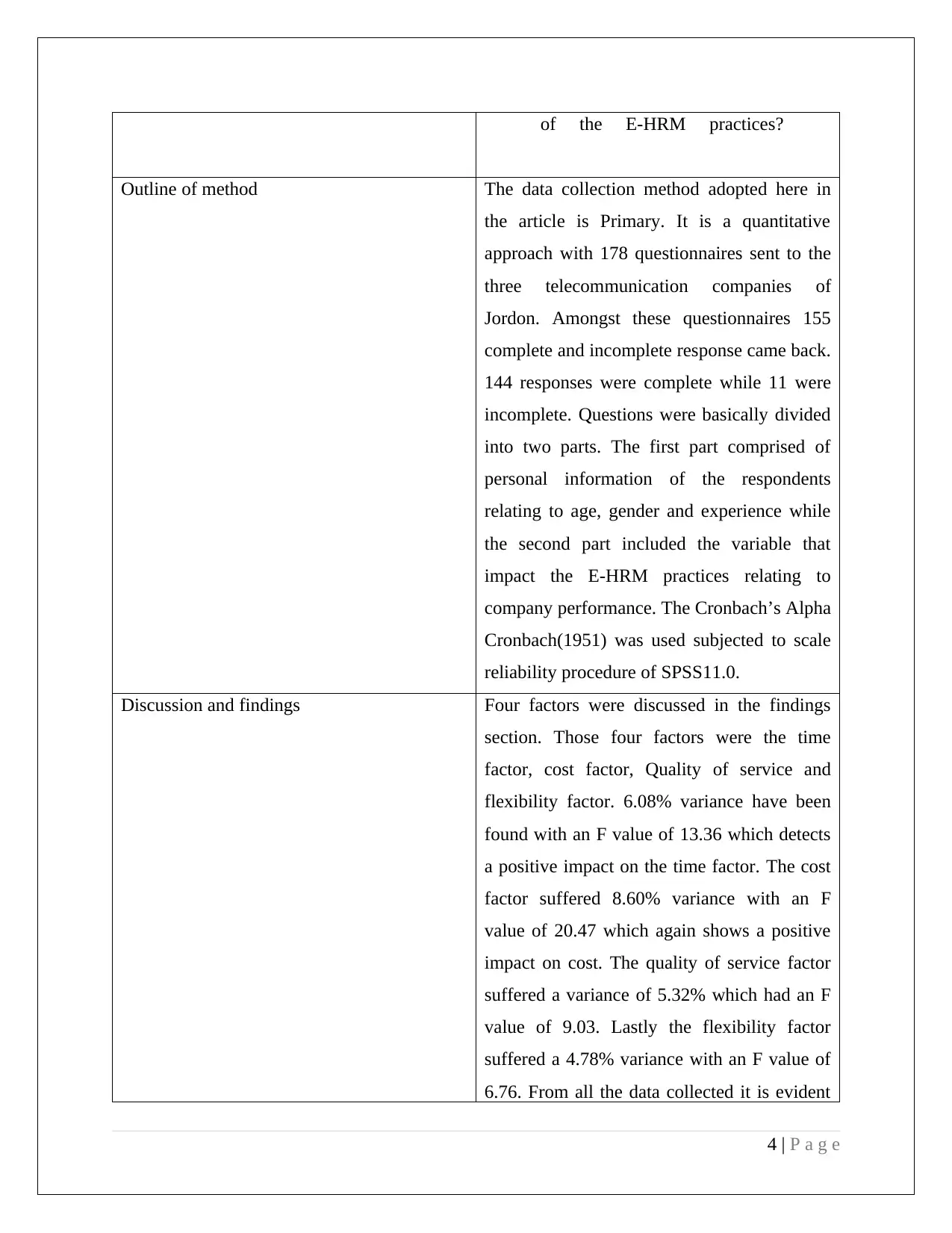
of the E-HRM practices?
Outline of method The data collection method adopted here in
the article is Primary. It is a quantitative
approach with 178 questionnaires sent to the
three telecommunication companies of
Jordon. Amongst these questionnaires 155
complete and incomplete response came back.
144 responses were complete while 11 were
incomplete. Questions were basically divided
into two parts. The first part comprised of
personal information of the respondents
relating to age, gender and experience while
the second part included the variable that
impact the E-HRM practices relating to
company performance. The Cronbach’s Alpha
Cronbach(1951) was used subjected to scale
reliability procedure of SPSS11.0.
Discussion and findings Four factors were discussed in the findings
section. Those four factors were the time
factor, cost factor, Quality of service and
flexibility factor. 6.08% variance have been
found with an F value of 13.36 which detects
a positive impact on the time factor. The cost
factor suffered 8.60% variance with an F
value of 20.47 which again shows a positive
impact on cost. The quality of service factor
suffered a variance of 5.32% which had an F
value of 9.03. Lastly the flexibility factor
suffered a 4.78% variance with an F value of
6.76. From all the data collected it is evident
4 | P a g e
Outline of method The data collection method adopted here in
the article is Primary. It is a quantitative
approach with 178 questionnaires sent to the
three telecommunication companies of
Jordon. Amongst these questionnaires 155
complete and incomplete response came back.
144 responses were complete while 11 were
incomplete. Questions were basically divided
into two parts. The first part comprised of
personal information of the respondents
relating to age, gender and experience while
the second part included the variable that
impact the E-HRM practices relating to
company performance. The Cronbach’s Alpha
Cronbach(1951) was used subjected to scale
reliability procedure of SPSS11.0.
Discussion and findings Four factors were discussed in the findings
section. Those four factors were the time
factor, cost factor, Quality of service and
flexibility factor. 6.08% variance have been
found with an F value of 13.36 which detects
a positive impact on the time factor. The cost
factor suffered 8.60% variance with an F
value of 20.47 which again shows a positive
impact on cost. The quality of service factor
suffered a variance of 5.32% which had an F
value of 9.03. Lastly the flexibility factor
suffered a 4.78% variance with an F value of
6.76. From all the data collected it is evident
4 | P a g e
Paraphrase This Document
Need a fresh take? Get an instant paraphrase of this document with our AI Paraphraser
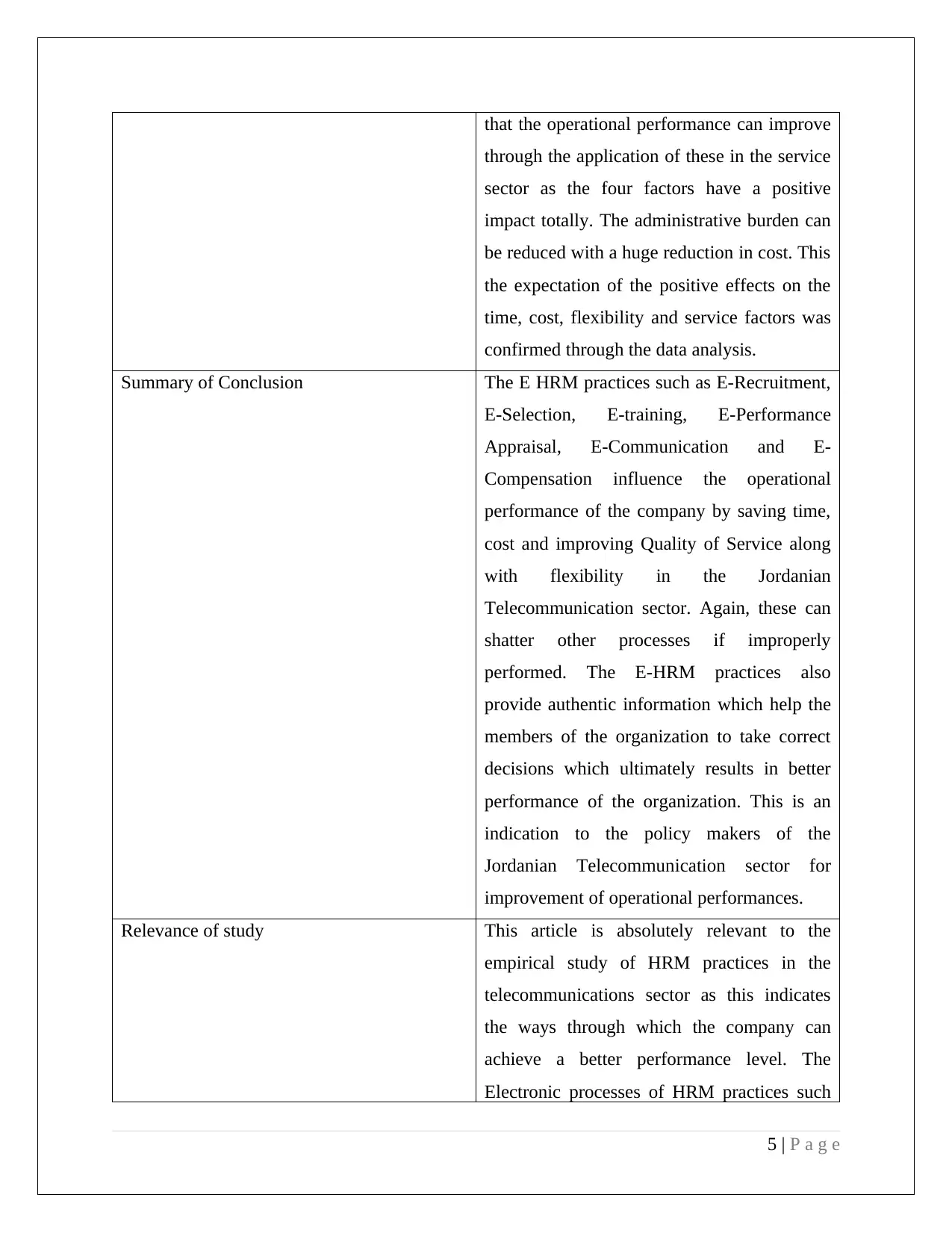
that the operational performance can improve
through the application of these in the service
sector as the four factors have a positive
impact totally. The administrative burden can
be reduced with a huge reduction in cost. This
the expectation of the positive effects on the
time, cost, flexibility and service factors was
confirmed through the data analysis.
Summary of Conclusion The E HRM practices such as E-Recruitment,
E-Selection, E-training, E-Performance
Appraisal, E-Communication and E-
Compensation influence the operational
performance of the company by saving time,
cost and improving Quality of Service along
with flexibility in the Jordanian
Telecommunication sector. Again, these can
shatter other processes if improperly
performed. The E-HRM practices also
provide authentic information which help the
members of the organization to take correct
decisions which ultimately results in better
performance of the organization. This is an
indication to the policy makers of the
Jordanian Telecommunication sector for
improvement of operational performances.
Relevance of study This article is absolutely relevant to the
empirical study of HRM practices in the
telecommunications sector as this indicates
the ways through which the company can
achieve a better performance level. The
Electronic processes of HRM practices such
5 | P a g e
through the application of these in the service
sector as the four factors have a positive
impact totally. The administrative burden can
be reduced with a huge reduction in cost. This
the expectation of the positive effects on the
time, cost, flexibility and service factors was
confirmed through the data analysis.
Summary of Conclusion The E HRM practices such as E-Recruitment,
E-Selection, E-training, E-Performance
Appraisal, E-Communication and E-
Compensation influence the operational
performance of the company by saving time,
cost and improving Quality of Service along
with flexibility in the Jordanian
Telecommunication sector. Again, these can
shatter other processes if improperly
performed. The E-HRM practices also
provide authentic information which help the
members of the organization to take correct
decisions which ultimately results in better
performance of the organization. This is an
indication to the policy makers of the
Jordanian Telecommunication sector for
improvement of operational performances.
Relevance of study This article is absolutely relevant to the
empirical study of HRM practices in the
telecommunications sector as this indicates
the ways through which the company can
achieve a better performance level. The
Electronic processes of HRM practices such
5 | P a g e
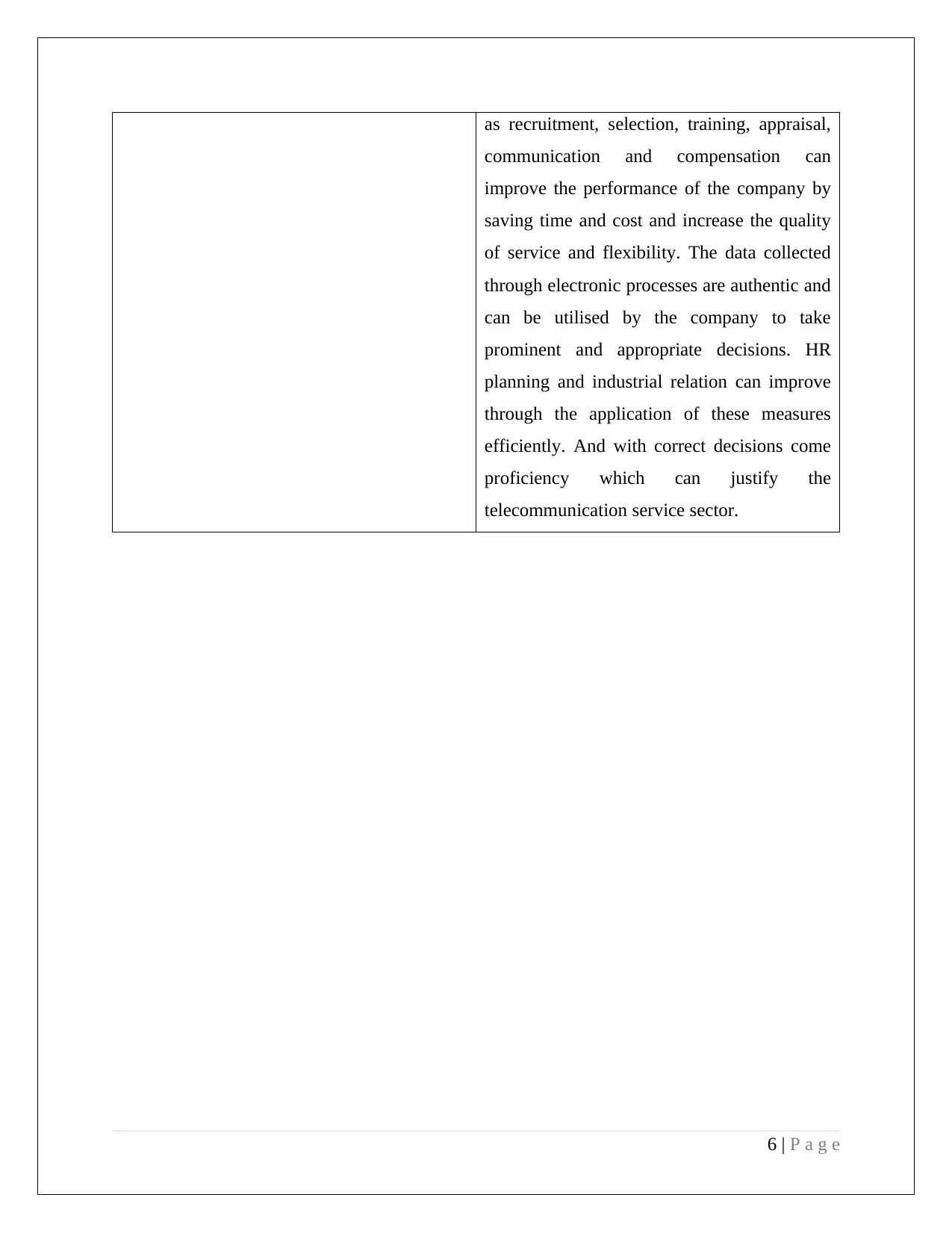
as recruitment, selection, training, appraisal,
communication and compensation can
improve the performance of the company by
saving time and cost and increase the quality
of service and flexibility. The data collected
through electronic processes are authentic and
can be utilised by the company to take
prominent and appropriate decisions. HR
planning and industrial relation can improve
through the application of these measures
efficiently. And with correct decisions come
proficiency which can justify the
telecommunication service sector.
6 | P a g e
communication and compensation can
improve the performance of the company by
saving time and cost and increase the quality
of service and flexibility. The data collected
through electronic processes are authentic and
can be utilised by the company to take
prominent and appropriate decisions. HR
planning and industrial relation can improve
through the application of these measures
efficiently. And with correct decisions come
proficiency which can justify the
telecommunication service sector.
6 | P a g e
⊘ This is a preview!⊘
Do you want full access?
Subscribe today to unlock all pages.

Trusted by 1+ million students worldwide
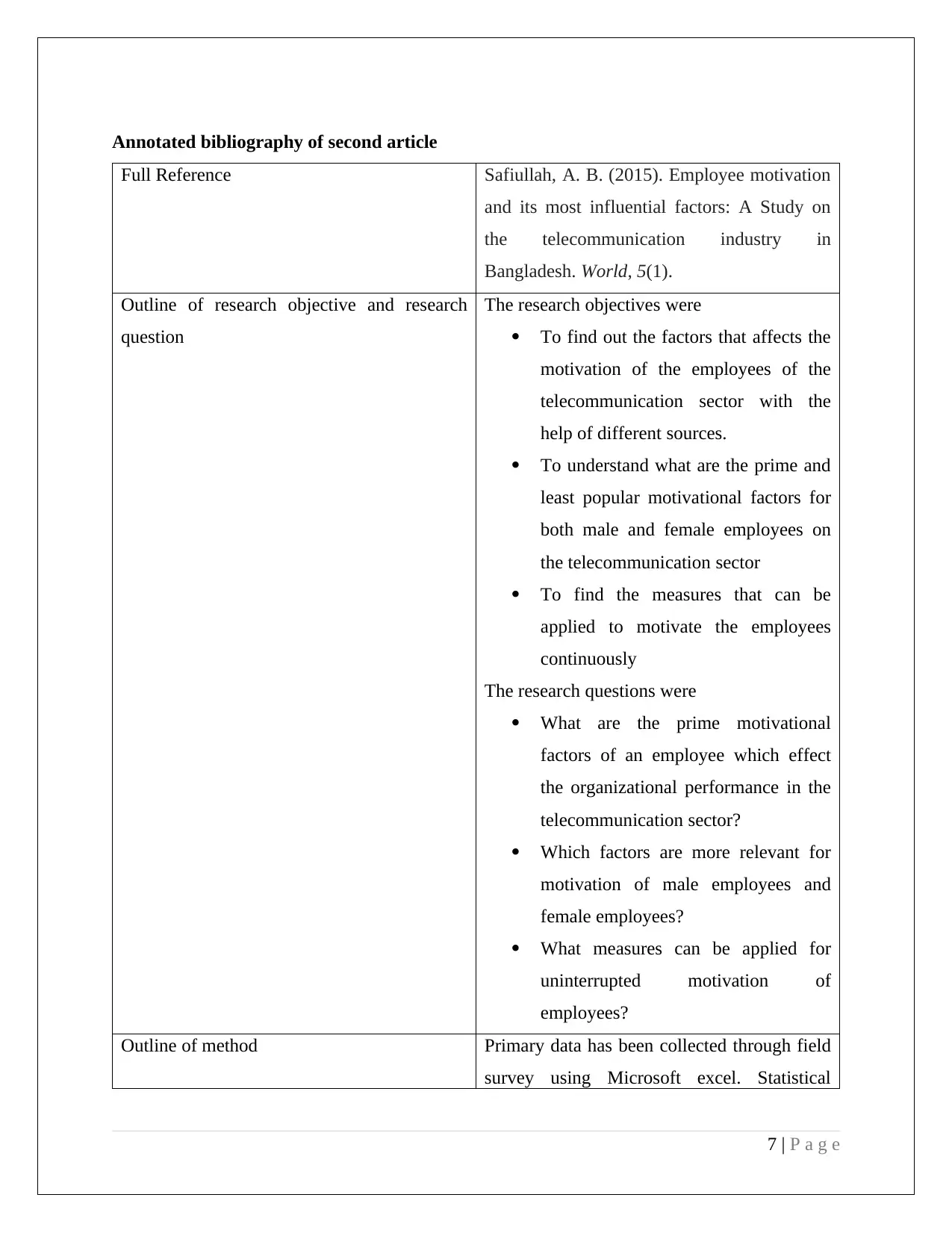
Annotated bibliography of second article
Full Reference Safiullah, A. B. (2015). Employee motivation
and its most influential factors: A Study on
the telecommunication industry in
Bangladesh. World, 5(1).
Outline of research objective and research
question
The research objectives were
To find out the factors that affects the
motivation of the employees of the
telecommunication sector with the
help of different sources.
To understand what are the prime and
least popular motivational factors for
both male and female employees on
the telecommunication sector
To find the measures that can be
applied to motivate the employees
continuously
The research questions were
What are the prime motivational
factors of an employee which effect
the organizational performance in the
telecommunication sector?
Which factors are more relevant for
motivation of male employees and
female employees?
What measures can be applied for
uninterrupted motivation of
employees?
Outline of method Primary data has been collected through field
survey using Microsoft excel. Statistical
7 | P a g e
Full Reference Safiullah, A. B. (2015). Employee motivation
and its most influential factors: A Study on
the telecommunication industry in
Bangladesh. World, 5(1).
Outline of research objective and research
question
The research objectives were
To find out the factors that affects the
motivation of the employees of the
telecommunication sector with the
help of different sources.
To understand what are the prime and
least popular motivational factors for
both male and female employees on
the telecommunication sector
To find the measures that can be
applied to motivate the employees
continuously
The research questions were
What are the prime motivational
factors of an employee which effect
the organizational performance in the
telecommunication sector?
Which factors are more relevant for
motivation of male employees and
female employees?
What measures can be applied for
uninterrupted motivation of
employees?
Outline of method Primary data has been collected through field
survey using Microsoft excel. Statistical
7 | P a g e
Paraphrase This Document
Need a fresh take? Get an instant paraphrase of this document with our AI Paraphraser
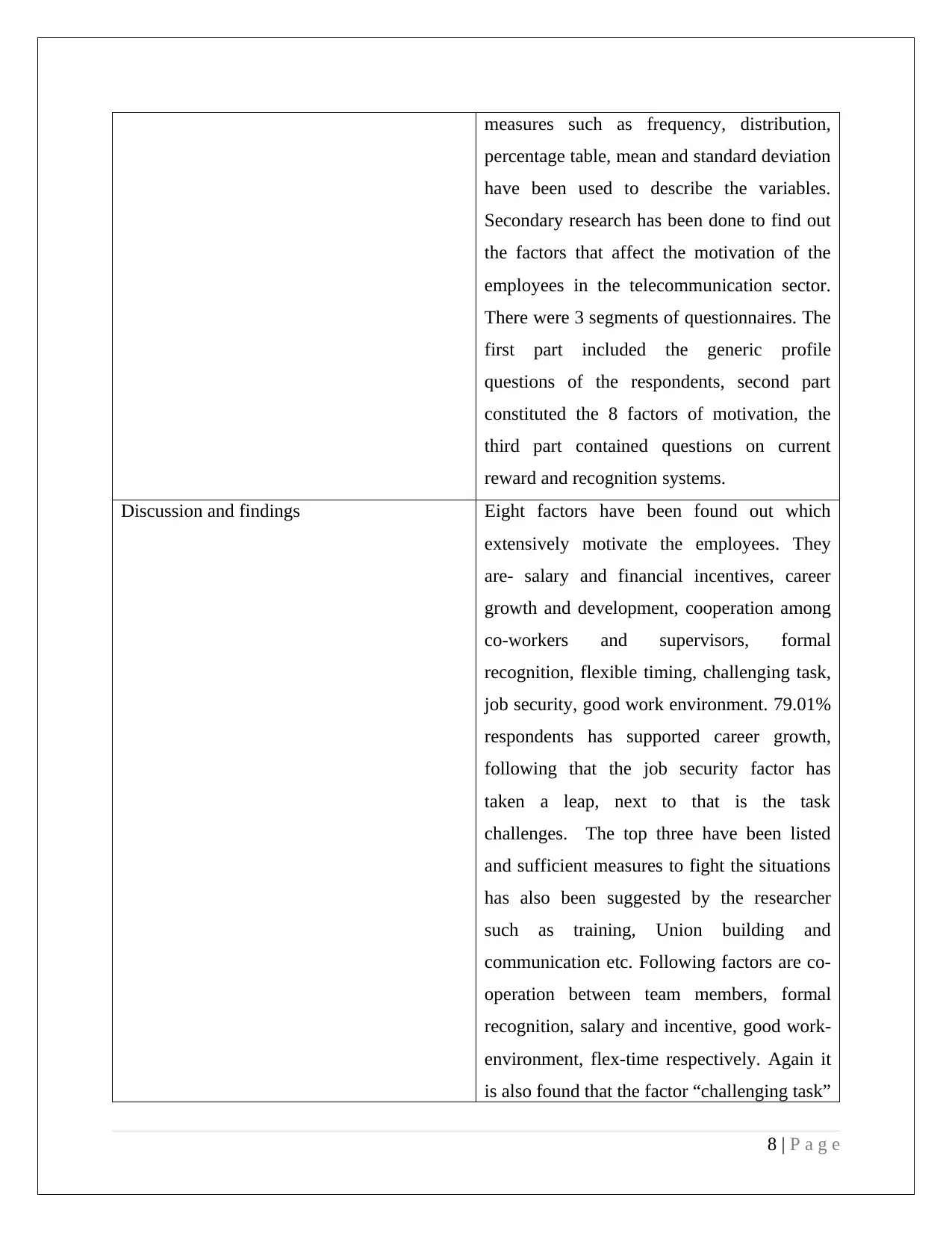
measures such as frequency, distribution,
percentage table, mean and standard deviation
have been used to describe the variables.
Secondary research has been done to find out
the factors that affect the motivation of the
employees in the telecommunication sector.
There were 3 segments of questionnaires. The
first part included the generic profile
questions of the respondents, second part
constituted the 8 factors of motivation, the
third part contained questions on current
reward and recognition systems.
Discussion and findings Eight factors have been found out which
extensively motivate the employees. They
are- salary and financial incentives, career
growth and development, cooperation among
co-workers and supervisors, formal
recognition, flexible timing, challenging task,
job security, good work environment. 79.01%
respondents has supported career growth,
following that the job security factor has
taken a leap, next to that is the task
challenges. The top three have been listed
and sufficient measures to fight the situations
has also been suggested by the researcher
such as training, Union building and
communication etc. Following factors are co-
operation between team members, formal
recognition, salary and incentive, good work-
environment, flex-time respectively. Again it
is also found that the factor “challenging task”
8 | P a g e
percentage table, mean and standard deviation
have been used to describe the variables.
Secondary research has been done to find out
the factors that affect the motivation of the
employees in the telecommunication sector.
There were 3 segments of questionnaires. The
first part included the generic profile
questions of the respondents, second part
constituted the 8 factors of motivation, the
third part contained questions on current
reward and recognition systems.
Discussion and findings Eight factors have been found out which
extensively motivate the employees. They
are- salary and financial incentives, career
growth and development, cooperation among
co-workers and supervisors, formal
recognition, flexible timing, challenging task,
job security, good work environment. 79.01%
respondents has supported career growth,
following that the job security factor has
taken a leap, next to that is the task
challenges. The top three have been listed
and sufficient measures to fight the situations
has also been suggested by the researcher
such as training, Union building and
communication etc. Following factors are co-
operation between team members, formal
recognition, salary and incentive, good work-
environment, flex-time respectively. Again it
is also found that the factor “challenging task”
8 | P a g e
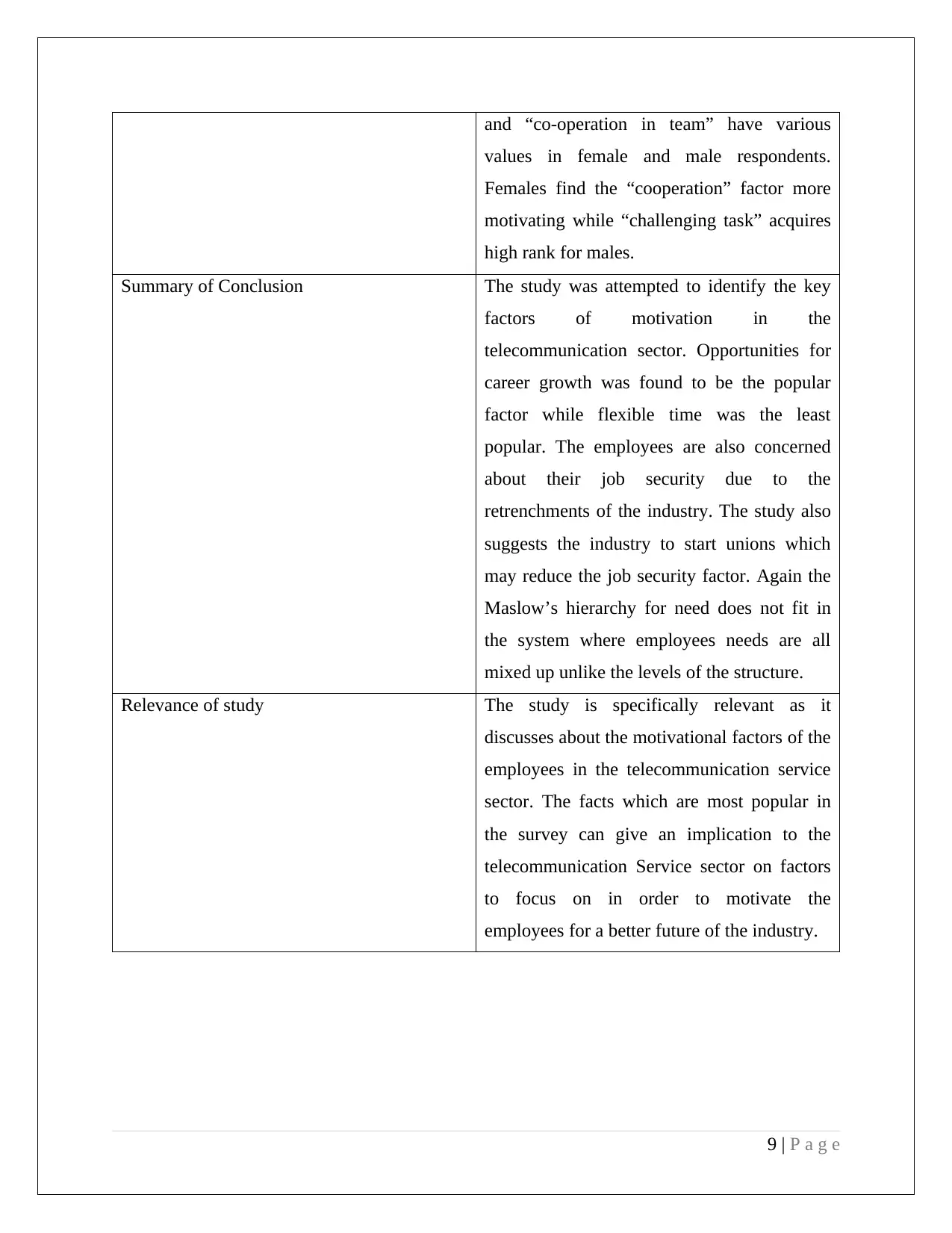
and “co-operation in team” have various
values in female and male respondents.
Females find the “cooperation” factor more
motivating while “challenging task” acquires
high rank for males.
Summary of Conclusion The study was attempted to identify the key
factors of motivation in the
telecommunication sector. Opportunities for
career growth was found to be the popular
factor while flexible time was the least
popular. The employees are also concerned
about their job security due to the
retrenchments of the industry. The study also
suggests the industry to start unions which
may reduce the job security factor. Again the
Maslow’s hierarchy for need does not fit in
the system where employees needs are all
mixed up unlike the levels of the structure.
Relevance of study The study is specifically relevant as it
discusses about the motivational factors of the
employees in the telecommunication service
sector. The facts which are most popular in
the survey can give an implication to the
telecommunication Service sector on factors
to focus on in order to motivate the
employees for a better future of the industry.
9 | P a g e
values in female and male respondents.
Females find the “cooperation” factor more
motivating while “challenging task” acquires
high rank for males.
Summary of Conclusion The study was attempted to identify the key
factors of motivation in the
telecommunication sector. Opportunities for
career growth was found to be the popular
factor while flexible time was the least
popular. The employees are also concerned
about their job security due to the
retrenchments of the industry. The study also
suggests the industry to start unions which
may reduce the job security factor. Again the
Maslow’s hierarchy for need does not fit in
the system where employees needs are all
mixed up unlike the levels of the structure.
Relevance of study The study is specifically relevant as it
discusses about the motivational factors of the
employees in the telecommunication service
sector. The facts which are most popular in
the survey can give an implication to the
telecommunication Service sector on factors
to focus on in order to motivate the
employees for a better future of the industry.
9 | P a g e
⊘ This is a preview!⊘
Do you want full access?
Subscribe today to unlock all pages.

Trusted by 1+ million students worldwide
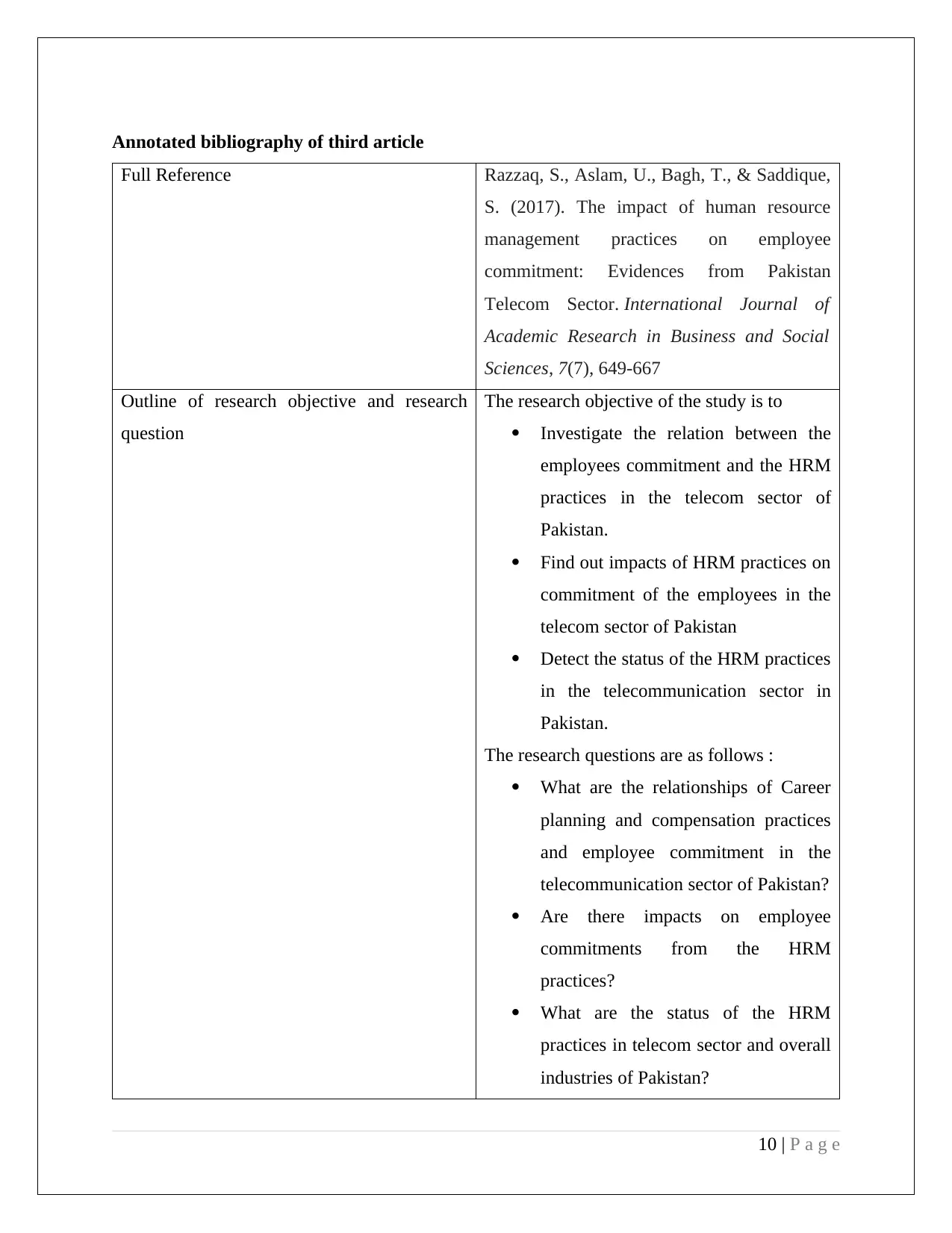
Annotated bibliography of third article
Full Reference Razzaq, S., Aslam, U., Bagh, T., & Saddique,
S. (2017). The impact of human resource
management practices on employee
commitment: Evidences from Pakistan
Telecom Sector. International Journal of
Academic Research in Business and Social
Sciences, 7(7), 649-667
Outline of research objective and research
question
The research objective of the study is to
Investigate the relation between the
employees commitment and the HRM
practices in the telecom sector of
Pakistan.
Find out impacts of HRM practices on
commitment of the employees in the
telecom sector of Pakistan
Detect the status of the HRM practices
in the telecommunication sector in
Pakistan.
The research questions are as follows :
What are the relationships of Career
planning and compensation practices
and employee commitment in the
telecommunication sector of Pakistan?
Are there impacts on employee
commitments from the HRM
practices?
What are the status of the HRM
practices in telecom sector and overall
industries of Pakistan?
10 | P a g e
Full Reference Razzaq, S., Aslam, U., Bagh, T., & Saddique,
S. (2017). The impact of human resource
management practices on employee
commitment: Evidences from Pakistan
Telecom Sector. International Journal of
Academic Research in Business and Social
Sciences, 7(7), 649-667
Outline of research objective and research
question
The research objective of the study is to
Investigate the relation between the
employees commitment and the HRM
practices in the telecom sector of
Pakistan.
Find out impacts of HRM practices on
commitment of the employees in the
telecom sector of Pakistan
Detect the status of the HRM practices
in the telecommunication sector in
Pakistan.
The research questions are as follows :
What are the relationships of Career
planning and compensation practices
and employee commitment in the
telecommunication sector of Pakistan?
Are there impacts on employee
commitments from the HRM
practices?
What are the status of the HRM
practices in telecom sector and overall
industries of Pakistan?
10 | P a g e
Paraphrase This Document
Need a fresh take? Get an instant paraphrase of this document with our AI Paraphraser
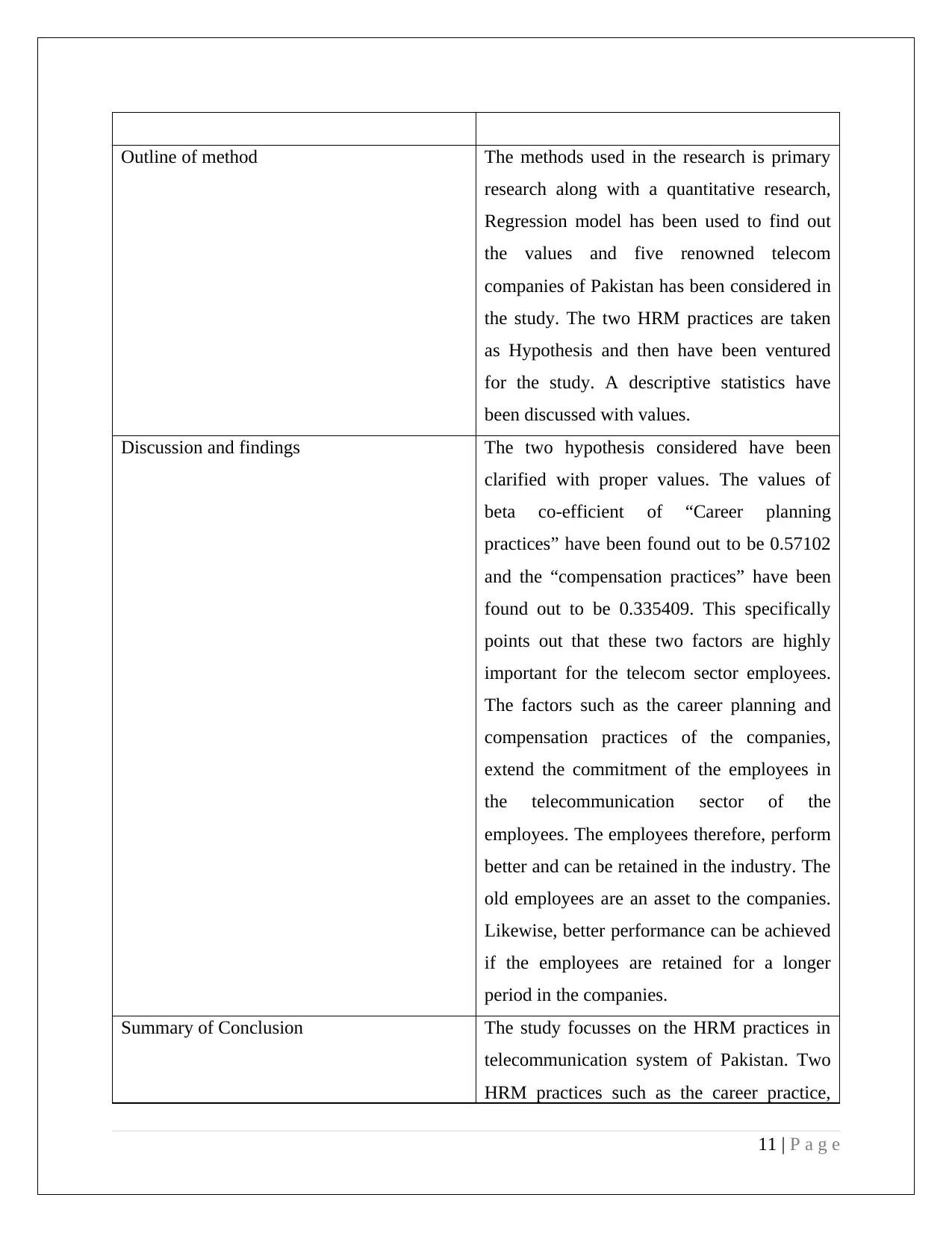
Outline of method The methods used in the research is primary
research along with a quantitative research,
Regression model has been used to find out
the values and five renowned telecom
companies of Pakistan has been considered in
the study. The two HRM practices are taken
as Hypothesis and then have been ventured
for the study. A descriptive statistics have
been discussed with values.
Discussion and findings The two hypothesis considered have been
clarified with proper values. The values of
beta co-efficient of “Career planning
practices” have been found out to be 0.57102
and the “compensation practices” have been
found out to be 0.335409. This specifically
points out that these two factors are highly
important for the telecom sector employees.
The factors such as the career planning and
compensation practices of the companies,
extend the commitment of the employees in
the telecommunication sector of the
employees. The employees therefore, perform
better and can be retained in the industry. The
old employees are an asset to the companies.
Likewise, better performance can be achieved
if the employees are retained for a longer
period in the companies.
Summary of Conclusion The study focusses on the HRM practices in
telecommunication system of Pakistan. Two
HRM practices such as the career practice,
11 | P a g e
research along with a quantitative research,
Regression model has been used to find out
the values and five renowned telecom
companies of Pakistan has been considered in
the study. The two HRM practices are taken
as Hypothesis and then have been ventured
for the study. A descriptive statistics have
been discussed with values.
Discussion and findings The two hypothesis considered have been
clarified with proper values. The values of
beta co-efficient of “Career planning
practices” have been found out to be 0.57102
and the “compensation practices” have been
found out to be 0.335409. This specifically
points out that these two factors are highly
important for the telecom sector employees.
The factors such as the career planning and
compensation practices of the companies,
extend the commitment of the employees in
the telecommunication sector of the
employees. The employees therefore, perform
better and can be retained in the industry. The
old employees are an asset to the companies.
Likewise, better performance can be achieved
if the employees are retained for a longer
period in the companies.
Summary of Conclusion The study focusses on the HRM practices in
telecommunication system of Pakistan. Two
HRM practices such as the career practice,
11 | P a g e
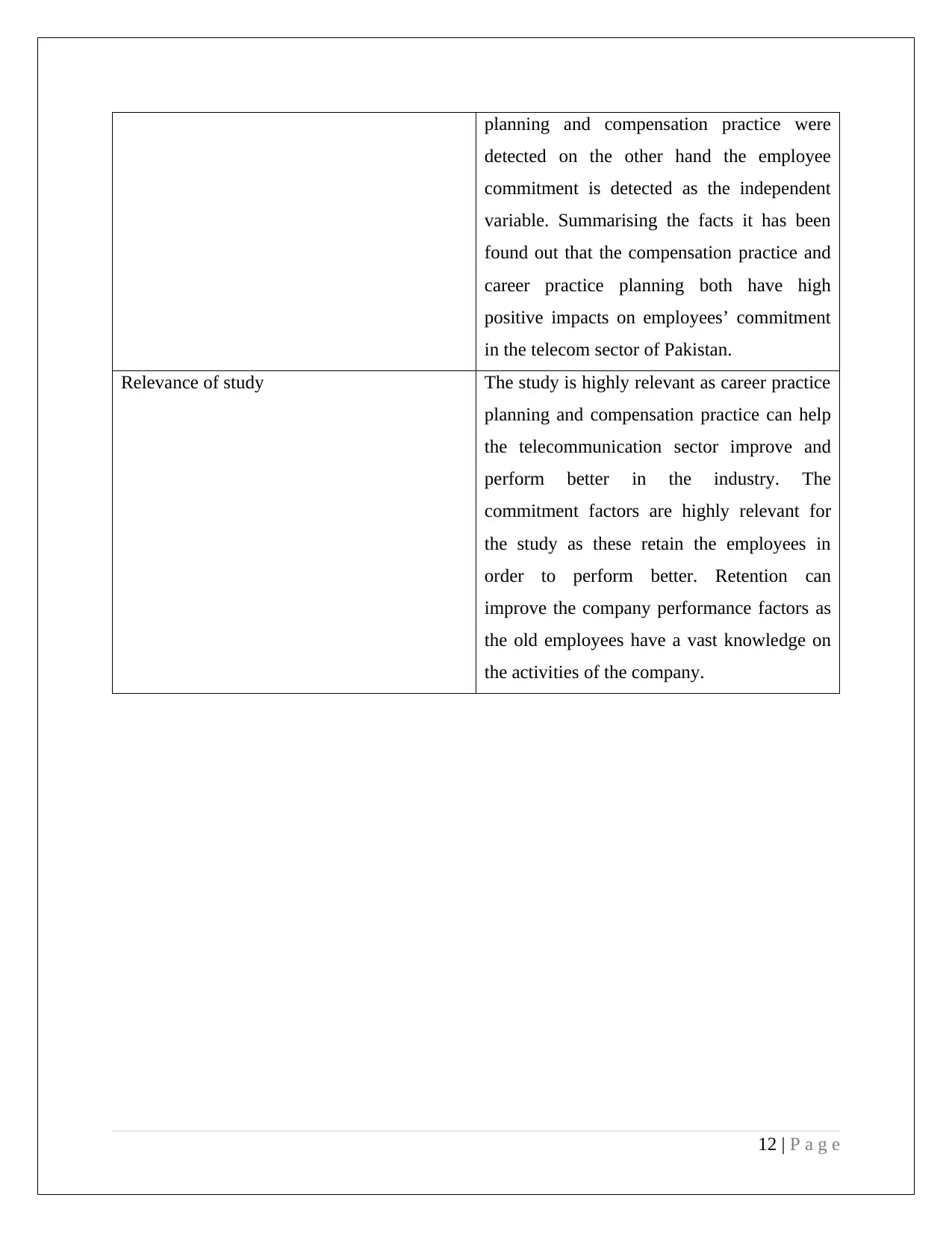
planning and compensation practice were
detected on the other hand the employee
commitment is detected as the independent
variable. Summarising the facts it has been
found out that the compensation practice and
career practice planning both have high
positive impacts on employees’ commitment
in the telecom sector of Pakistan.
Relevance of study The study is highly relevant as career practice
planning and compensation practice can help
the telecommunication sector improve and
perform better in the industry. The
commitment factors are highly relevant for
the study as these retain the employees in
order to perform better. Retention can
improve the company performance factors as
the old employees have a vast knowledge on
the activities of the company.
12 | P a g e
detected on the other hand the employee
commitment is detected as the independent
variable. Summarising the facts it has been
found out that the compensation practice and
career practice planning both have high
positive impacts on employees’ commitment
in the telecom sector of Pakistan.
Relevance of study The study is highly relevant as career practice
planning and compensation practice can help
the telecommunication sector improve and
perform better in the industry. The
commitment factors are highly relevant for
the study as these retain the employees in
order to perform better. Retention can
improve the company performance factors as
the old employees have a vast knowledge on
the activities of the company.
12 | P a g e
⊘ This is a preview!⊘
Do you want full access?
Subscribe today to unlock all pages.

Trusted by 1+ million students worldwide
1 out of 18
Related Documents
Your All-in-One AI-Powered Toolkit for Academic Success.
+13062052269
info@desklib.com
Available 24*7 on WhatsApp / Email
![[object Object]](/_next/static/media/star-bottom.7253800d.svg)
Unlock your academic potential
Copyright © 2020–2025 A2Z Services. All Rights Reserved. Developed and managed by ZUCOL.





